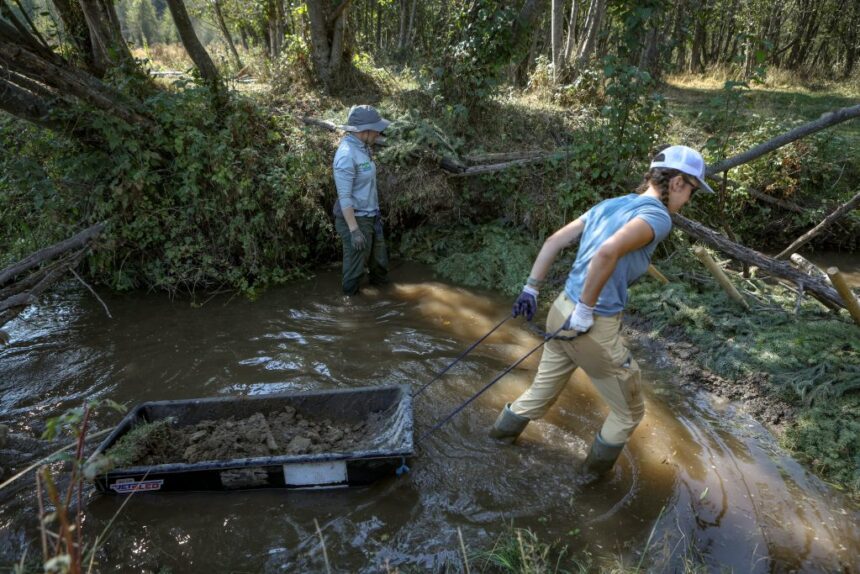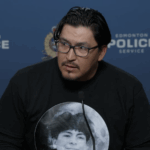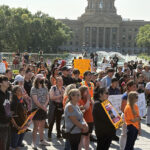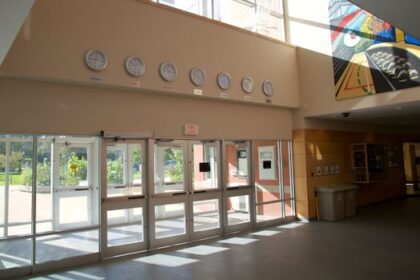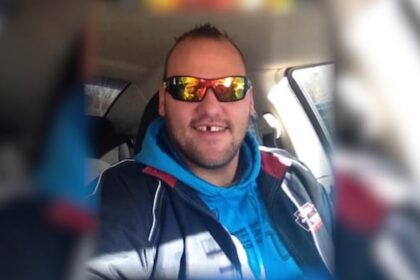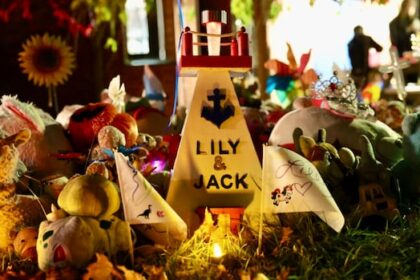Often seen as a ‘nuisance’ species to be trapped and removed, stunx — beaver in nsyilxcən — may be a key to restoring wetlands and watersheds amidst deforestation and climate change Members of B.C. Wildlife Federation’s watershed team, Kyla Rushton, right, and Katie Blokker, build a beaver dam analogue along Coteay Creek on Sept. 10. Photo by Aaron Hemens Last year, while completing a wetland assessment with the B.C. Wildlife Federation in the highlands above sw̓iw̓s (Osoyoos), Delaney Hall came across the remnants of an old beaver dam along Coteay Creek. As the Osoyoos Indian Band member continued on along the now-depleted waterway, Hall identified evidence of 36 more former dams, all of which were abandoned along a five-kilometre stretch. Twenty of those 37 dams were still in good enough condition to be patched up. Some have already been repaired, enabling them to hold back water to create the ponds and reservoirs that make dams so valuable to wetland ecosystems. About 15 kilometres downstream from the Mount Baldy ski resort, Coteay Creek quietly meanders through a large open field. This area surrounding the creek has become more like a grassland as the wetland has dried up and the beavers — or stunx as they’re known in nsyilxcən — have disappeared. Delaney Hall, a tmixʷ (wildlife) technician with the Okanagan Nation Alliance and a member of the Osoyoos Indian Band, gestures towards a pool forming along Coteay Creek on Sept. 10. The deeper water is the result of a human-made beaver dam analogue. Photo by Aaron Hemens “There haven’t been beavers up here for like 30-plus years,” said Hall, a tmixʷ (wildlife) technician with the Okanagan Nation Alliance (ONA). “There used to be millions and millions of beavers, and now there’s not very many up in the highlands anymore.” But by mimicking beaver structures, people are determined to coax them back, explained Hall. “Once you start restoring some of this area, the vegetation starts coming back. And beavers have been known to take over after,” he said. In the second week of September, Hall led a project with ONA, Osoyoos Indian Band (OIB) and the B.C. Wildlife Federation. The team installed eight manufactured beaver dams along a one-kilometre stretch of Coteay Creek in this open field, in an effort to help revitalize the surrounding wetland’s ecosystem. Between the human-made dam structures – also known as beaver dam analogues (BDAs) – the crew also implemented eight additional artificial creek obstructions to mimic natural log jams. They’re known as post-assisted-log structures (PALS). “When trees fall over into the creek, it directs the water to the side,” said Hall, a member of OIB. “We’re using that to help widen out the system, because it’s so low.” By helping slow water flow downstream with sticks, beavers are seen as a ‘keystone species’ for many wetland ecosystems. Photo courtesy Parks Canada ‘The glue that holds habitats together’ Coteay Creek is a tributary of akskʷəkʷant (Inkaneep Creek), which flows into suwiw̓s (Osoyoos Lake). The headwaters of both Coteay and Inakneep creeks are located just below Mount Baldy. Before the fur trade and settler colonialism decimated the population of beavers in syilx homelands, the semi-aquatic rodents and their dams played a critical role in the ecological functions of local wetlands. “There used to be like 400 million beavers they estimate, in the country,” Hall said. “And now, there’s a huge difference,” noting that there’s roughly 12 to 15 million left. Hall estimates that up to 90 per cent of the province’s wetlands have been lost, and he said much of that loss is linked to the disappearance of beavers from the landscape. Delaney Hall, a tmixʷ (wildlife) technician with the Okanagan Nation Alliance, points towards a wetland ecosystem created by beaver activity in upstream Coteay Creek on Sept. 10. Photo by Aaron Hemens “They had wetlands all over the place, like in every waterway,” he explained. “People need to understand that beavers are a keystone species. “They are the glue that holds habitats together.” Just a few steps from a turn in the creek and into the field, what appears to be a small mound in the ground to the untrained eye is actually the remnants of the lowest beaver structure in Coteay Creek’s former beaver dam system. Upon finding the former natural beaver dams, he spoke with some Elders in OIB, who pointed on a map to where they’d previously seen signs of beavers. “You talk to some of the Elders, they remember beavers in places where the evidence is totally gone now,” he said. The spot one of the Elders identified “was the exact same place I was talking about,” Hall said. He recounted the Elder telling him, “Years ago, that whole [area] — where there’s no trees and stuff — that was all underwater, that was all beaver dam. It was an old wetland back there.” An aerial view looking upstream show crews working along on Coteay Creek on Sept. 10, as they create two beaver dam analogues and two post-assisted-log structures. Photo by Aaron Hemens When beavers are allowed to build their dams unimpeded, those structures act like speed bumps to slow a stream’s flow. They result in pools that hold water along a waterway’s route, Hall said. “Beavers create the environment that best suits them,” he explained. “If you ever see a beaver on land, it waddles pretty slow.” Pools of deeper water are an ideal place for the rodents to swim freely, where they build their dens and canals, the latter serving as “highways for beavers,” according to Emily Fairfax, an assistant professor of geography at the University of Minnesota. The canals are “little micro streams” that stem from beaver ponds, “across valley bottoms and different landscapes,” Fairfax explained at a webinar the ONA hosted in July. “The pond is definitely a very large and important surface water feature, but the canals take a beaver from influencing half a square kilometre of land, to influencing multiple square kilometres of land,” she said. Coteay Creek is a tributary of akskʷəkʷant (Inkaneep Creek), which flows into suwiw̓s (Osoyoos Lake). The headwaters of both Coteay and Inakneep Creeks are located just below Mount Baldy. Map screenshot courtesy of Natural Resources Canada Their dams slow down flowing water, spreading it out into floodplains and wetlands. “It helps recharge the ground water and it slowly releases it over time,” Hall said. “When you don’t have any of that in a stream system, the water starts to channelize and then it starts to dig itself down.” In other words, streams become faster without beaver dams — they widen and straighten, rather than meander, and contribute to the erosion of a stream’s bed. Beaver dams make landscapes fire-resistant Wetlands are critical habitat not just for other aquatic beings such as fish and amphibians, but also land animals, including moose, deer and elk, Hall explained. But with more frequent droughts causing a growing number of streams to dry up, he said “it’s hard out here for the animals.” “We see them as our relatives,” he added. “They help us sustain our lives, so we gotta help take care of them as well.” And since beaver dams enable wetlands to keep their surrounding lands moist and green, they act as natural fire breaks, too. Fairfax said that beaver-dammed areas are about three times more fire-resistant than rivers without beavers. A bee sits on a flower near a beaver dam analogue being built on Coteay Creek on Sept. 10. Beaver dams help wetlands keep their surrounding lands moist and green, acting as natural fire breaks. Photo by Aaron Hemens Fairfax explained that during “megafires,” ecosystems with beaver activity in them offer significant protection from wildfires, becoming what are called “fire refugia” — areas that remain mostly unburned, or experience only low-intensity fires. “That is helpful and beneficial for the soil and the organisms,” she said. “It’s really important to have fire refugia available. These are the places that animals will seek out to survive the fire, especially those that can’t outrun a fire.” Additionally, devastating floods and droughts are less likely to occur where there are multiple beaver dams along a waterway, because their structures slow water down and spread it out into the ground, absorbing water and holding it. A wetland is “like a giant sponge,” Hall said. “It just soaks it all up, and slowly releases it over time.” Beaver dams help cool water temperatures for salmon In watersheds’ highlands, beaver dams also help regulate water temperatures downstream, because they store cooler water up higher for longer periods, slowly releasing it throughout the whole year instead of all at once. This cold water filtering into waterways also supports salmon as they return to spawn, which thrive in cooler temperatures. “When we had beavers in the system,” Hall said, “we had more fish than we could count.” But with a lack of beaver dams slowing and holding water, as is the case at Coteay Creek, the water descending from its headwaters flows “so fast now,” Hall lamented. “More material and sediments have been filling our rivers, which has been destroying fish habitat.” Snowpacks in the territory are already melting more quickly due to warming temperatures brought on by climate change. But Hill said clearcut logging in the headwaters is accelerating this process. It’s not only tree canopies that help reduce local temperatures. As more snowmelt and rain run off deforested parts of watersheds, these areas also suffer from further erosion due to cattle grazing, and landslides linked to flooding — all of which increases waterflow in streams and creeks, he explained. A cow stands near a recently installed beaver dam analogue along Coteay Creek on Sept. 10. Photo by Aaron Hemens “It has degraded them, and they have suffered lots of erosion,” he said. “Now we are faced with less snow every year.” And unless watersheds are protected from top to bottom, he argued, “it will continue to be an uphill battle.” “There are such huge cumulative impacts in the upper watershed from forestry, mining — all the other users,” said qʷəqʷim̓cxn Tessa Terbasket, the siwɬkʷ (water) program lead for ONA. “But also climate change — these megafires that have been going through and changing the water.” ‘Imitate the beaver’ Terbasket said that protecting upper watersheds throughout the territory should be a priority. “There’s less things up there now that hold the water back and slow the water down in the watershed,” she said. “Our system here is very dependent on that — if the water’s not being held up there, and we’re not getting that much snowpack, that means that we are in a drought for the year.” While frogs, rainbow and brook trout can be spotted within Coteay Creek, most of the four-legged animals found roaming its nearby fields nowadays are cows and wild horses, with black bears and their cubs seen occasionally, too. Wild horses gather in an open field near Coteay Creek on Sept. 10, nearby 16 beaver mimicry structures installed along the waterway. Photo by Aaron Hemens On top of the lack of maintained beaver dams slowing the creek’s flow, years of cattle trampling across Coteay Creek have also eroded the creekbed, cutting up to two metres into the ground in places. Knowing beaver dams’ ability to help naturally maintain the creek’s health and keep water in the wetlands, Hall felt this stretch of the waterway would be the perfect spot to install human-made BDA structures to mimic a beaver dam’s functions. ‘Dirt lasagna’: How to fake a beaver dam Beaver dam analogues are built by packing layers upon layers of locally harvested fir branches with mud from the creek. The mud is spread and firmed along the upstream side of the structure, reinforcing it and enabling water to slowly trickle down on its other side. “Basically, we’re trying to imitate the way a beaver dam is built,” said Hall. Leanne McDonald, a biologist with the federation, compared the technique to a “dirt lasagna.” “The BDAs are here to help hold back that water, so that it’s not straight-shooting further down,” the intermediate restoration biologist explained. The B.C. Wildlife Federation compares building a beaver dam analogue (BDA) to making a ‘dirt lasagne.’ Members of the organization’s watershed team, Kyla Rushton, right, and Katie Blokker, add soil to a BDA along Coteay Creek on Sept. 10. Photo by Aaron Hemens The federation has been installing BDAs in waterways across the province for years through their 10,000 Wetlands project. But the beaver mimicry initiative in Coteay Creek was the first such pilot installation for ONA, which hopes will lead to similar projects in upper watersheds throughout its territories. “We want to be doing it shoulder-to-shoulder with everybody,” Terbasket said, “because we just see that we need to be doing this work. It just makes so much sense.” On Sept. 10, McDonald was among five B.C. Wildlife staff members on site to train their ONA and OIB counterparts on the technique. Natural resource officers with the Lower Similkameen Indian Band (LSIB) also joined the crew later that week, hoping to take the idea back to their own watersheds. “We would love for ONA to be able to do this themselves,” McDonald said, “to have the capacity and the know-how to go find these sites.” Okanagan Nation Alliance ecologist and ecosystems project manager Kasey Moran, right, works on a beaver dam analogue on Sept. 10 alongside members of B.C. Wildlife Federation’s watershed team Kyla Rushton, left, and Katie Blokker. Photo by Aaron Hemens ‘It’s really rewarding work’ The team also installed large poles to strengthen both the BDAs and post-assisted-log structures, to keep them in place and to deter cattle from walking across the structures. Cattle crossing the waterway has caused a lot of “degradation that we’re seeing” in the creek, McDonald said. “We’re hoping that by raising the water levels, it will discourage them from wanting to walk through here,” she said. Their efforts started to pay off quickly. As they installed the structures over a week, they soon noticed the water level beginning to rise, with pools starting to slowly fill in. “It’s immediate satisfaction and gratification building these structures,” McDonald said. “You see the results immediately. It’s really rewarding work.” The pools behind each artificial beaver dam are also designed to trap sediment as water trickles through. That sediment will help raise up the creek bottom, increasing water levels with it and helping restore nearby floodplains. As the creek waters widen further into their adjacent flats, the hope is for BDAs to trap sediments and encourage the waterway to meander across the plain. “The more the water meanders, the better it spreads it out,” Hall explained. “It gets everything greener in a wider area.” As waters are slowed by beaver structures, they meander more and help their surroundings stay greener. An aerial view looking upstream of crews working along on Coteay Creek, with two beaver dam analogues and two post-assisted-log structures within the frame, on Sept. 10. Photo by Aaron Hemens As the structures were being built, the crews regularly used a staff gauge to measure a pool’s water levels on the downstream side of each BDA, to see how much water was flowing through it. “We constantly check to make sure that the water hasn’t dropped too much,” said Hall. “If it starts to go down one or two cm, then we stop and let the pool fill up, and let it start going over the top again. Let the flow do its thing again, and then we’ll start to build it up.” Crews were careful not to build the BDAs too tall too fast, however, as the structures could blow out come spring when freshet meltwaters make their way down from the headwaters. They plan to return next year to build them back up, and address any broken or sediment-clogged dams up. The goal, Hall said, is to prevent the dams from fully blocking the flow. “It’s always constant,” he said. “After they’re all built in, the flow never changes … It’s the same amount of water going through. It just slows it down.” McDonald said they’ll check on the structures twice more next year, during high flows in the spring and low flows in the fall. They’ll also gather data and do any needed maintenance, such as adding more layers. Eventually, Hall said they want to build BDAs farther upstream, closer to the headwaters, which would extend the dams’ current one-kilometre stretch six-fold. “We want to start at the headwaters and keep more of that cold water up in the high country for longer,” he said. “That’s the goal.” B.C. Wildlife Federation biologist Leanne McDonald helps build a beaver dam analogue along Coteay Creek on Sept. 10. Photo by Aaron Hemens Return of the beaver The BDAs can survive from between two to 15 years, McDonald said. The secret to even longer-lasting structures, however, is to attract actual beavers. That, she said, “is the ultimate goal” — to “have beavers on the landscape maintaining them for you.” Fairfax, at the University of Minnesota, agreed restoring the species to local watersheds is vital. “You shouldn’t be building their structures,” she said, “if you don’t want the beavers back.” Hall and McDonald both envision a day when the large rodents return to their former habitats, ideally to take over maintaining the artificial structures — and once again steward their surrounding wetlands. “Beavers are attracted to the sound of water, and that’s where they go,” said Terbasket. A technician walks upstream through a pool of water beginning to develop as a beaver dam analogue is built along Coteay Creek on Sept. 10. Photo by Aaron Hemens Although it might be hard to imagine how beavers would find their way to a BDA on a creek they’ve not used in years, McDonald said there’s “a great opportunity” in the province because the species are often seen as a “nuisance.” “People are trapping beavers in areas where they can’t co-exist with people,” she said. “We can release them here and they can take over a site like this.” But it’s not just beavers who have the potential to come back to Coteay Creek. Other wildlife are expected to return to the wetlands, too, once the structures rejuvenate the ecosystem. Hall predicts that “all sorts” of birds would return to a healthy wetland in the area, along with other mammals such as mink, marten and muskrat. “It’s like a magnet for all wildlife,” he said. A recently built beaver dam analogue along Coteay Creek on Sept. 10. Photo by Aaron Hemens ‘We need to act now’ One week after helping out at Coteay Creek, the B.C. Wildlife Federation crew assisted another syilx member community, Westbank First Nation, with similar beaver mimicry work, helping install BDAs in a headwater zone of the Derickson Swamp wetland system. Terbasket said communities throughout the Nation are really keen to be starting this work in their own watersheds. “Doing beaver mimicry work in the upper watershed really seems like a no-brainer,” she said. “Let’s learn to do this together, but also it’s so important to get our Elders’ and knowledge-keepers’ input and direction.” Equally crucial, she added, is “syilx-ifying” this Western-science approach to beaver mimicry, she said. “What’s our nsyilxcen words for it?” Terbasket asked. “What’s the protocol and ceremonies that we need to also be doing for this work for it to be successful?” She said that Elders and other community members have also said they prioritize protecting and restoring their upper watersheds. Hall said the nation plans to build hundreds of BDAs every year throughout their territory. He identified the headwaters of Vaseux Creek and McIntyre Creek as other waterways that would benefit from the efforts, as they are “dangerously close to drying up in the summertime,” he said. They’re important spawning grounds for sockeye and chinook salmon in the Okanagan River system. “We have so many fish coming back,” he said. “Now we need all the spawning areas that we can get.” Shuttleworth Creek has seen its waters become dangerously slow, he said, stranding hundreds of fish. Billy Hall, an environmental technician with the Osoyoos Indian Band, installs poles to strengthen a post-assisted-log structure along Coteay Creek with BC Wildlife’s Geneva Bahen and Leanne McDonald on Sept. 10. Photo by Aaron Hemens He also listed numerous other waterways in the area that would benefit from beaver mimicry: Creeks like the Shingle, Ellis, and Mission; and rivers such as the Nicola, Salmon and Similakmeen. “We must stand up together and protect the ones that have stood up before us, to help us sustain our lives,” Hall said. “We must protect our relatives — the ones who cannot speak for themselves. For we are the caretakers of this land.” But to take care of the Okanagan Nation’s watersheds, he warned, “we need to act now … for future generations.” And beaver dams are not just an ecosystem and climate matter, either: “Our way of life is being threatened,” Hall said Beaver mimicry, and in turn trying to attract beavers back to their former environments, he believes, will “help make some real change.” “More and more of our waterways have been drying up in the summertime now,” he said. “Beavers can help change that, and revive our wetlands.”
Tuesday, 25 Nov 2025
Canada – The Illusion
Search
Have an existing account?
Sign In
© 2022 Foxiz News Network. Ruby Design Company. All Rights Reserved.
You May also Like
- More News:
- history
- Standing Bear Network
- John Gonzalez
- ᐊᔭᐦᑊ ayahp — It happened
- Creation
- Beneath the Water
- Olympic gold medal
- Jim Thorpe
- type O blood
- the bringer of life
- Raven
- Wás’agi
- NoiseCat
- 'Sugarcane'
- The rivers still sing
- ᑲᓂᐸᐏᐟ ᒪᐢᑿ
- ᐅᑳᐤ okâw — We remember
- ᐊᓂᓈᐯᐃᐧᐣ aninâpêwin — Truth
- This is what it means to be human.
- Nokoma


